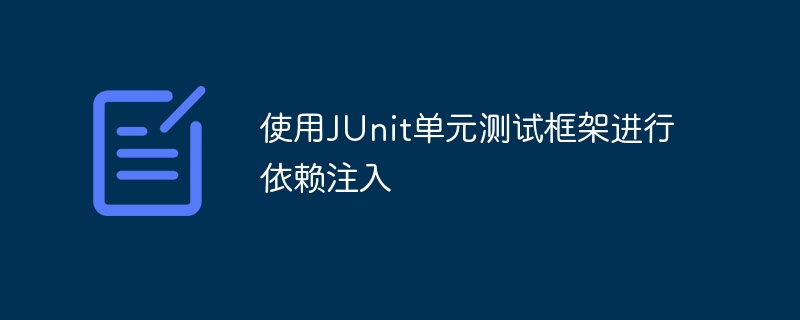 Java
Java javaTutorial
javaTutorial Dependency injection and inversion of control in data access layer design in Java framework
Dependency injection and inversion of control in data access layer design in Java frameworkIn the Java framework, the Data Access Layer (DAL) uses Dependency Injection (DI) and Inversion of Control (IoC) to pass dependencies to objects, thereby separating business logic from data access operations. DI injects dependencies into classes instead of manual instantiation, improving testability and maintainability. IoC transfers control from the class that creates the object to the container, simplifying object creation and lifecycle management. Advantages of DAL, DI, and IoC include loose coupling, scalability, reusability, and reduced complexity.

Dependency Injection and Inversion of Control in Data Access Layer Design in Java Framework
Introduction
Dependency Injection (DI) and Inversion of Control (IoC) is a design pattern in which one object creates a dependency on other objects. In the data access layer (DAL), dependency injection helps separate business logic from data access operations.
Dependency Injection
DI is the process of passing dependencies to classes instead of manually instantiating them. In Java applications, DI can be implemented using a dependency injection framework such as Guice, Spring Framework, or Dagger.
The following is an example of using Guice to implement DI:
@Inject
private UserDao userDao;
public class UserService {
// ...
}
public class UserServiceModule extends AbstractModule {
@Override
protected void configure() {
bind(UserDao.class).to(UserDaoImpl.class);
}
}Inversion of Control
IoC is a design pattern in which control is created from The object of the object is transferred to the container. In a Java application, the dependency injection container is responsible for creating and managing objects and their dependencies.
The following is an example of using Spring Framework to implement IoC:
<bean id="userDao" class="com.example.UserDaoImpl"/>
<bean id="userService" class="com.example.UserService">
<property name="userDao" ref="userDao"/>
</bean>Practical case
Let us consider a user that needs to be saved and retrieved from the database app. Using the DAL design pattern, we can create a UserRepository class that encapsulates operations on the database.
UserRepository.java
public interface UserRepository {
void save(User user);
User findById(long id);
}Next, we can create a UserRepositoryImpl class that implements the UserRepository interface and interacts with the database.
UserRepositoryImpl.java
public class UserRepositoryImpl implements UserRepository {
@Override
public void save(User user) {
// ...
}
@Override
public User findById(long id) {
// ...
}
}Finally, we can create a UserService class that uses UserRepository to handle users.
UserService.java
public class UserService {
private final UserRepository userRepository;
public UserService(UserRepository userRepository) {
this.userRepository = userRepository;
}
public void createUser(User user) {
userRepository.save(user);
}
}Advantages
The main advantages of using DAL, DI and IoC include:
- Loose coupling: It separates business logic from data access operations, thereby improving testability and maintainability.
- Extensibility: Data access implementations can be easily added or replaced without changing existing code.
- Reusability: Dependency injection allows components to be reused in different parts of the application.
- Reduced complexity: IoC containers simplify object creation and lifecycle management.
The above is the detailed content of Dependency injection and inversion of control in data access layer design in Java framework. For more information, please follow other related articles on the PHP Chinese website!
 手把手带你了解Angular中的依赖注入Dec 02, 2022 pm 09:14 PM
手把手带你了解Angular中的依赖注入Dec 02, 2022 pm 09:14 PM本篇文章带大家了解一下依赖注入,介绍一下依赖注入解决的问题和它原生的写法是什么,并聊聊Angular的依赖注入框架,希望对大家有所帮助!
 在Phalcon框架中使用依赖注入(Dependency Injection)的方法Jul 30, 2023 pm 09:03 PM
在Phalcon框架中使用依赖注入(Dependency Injection)的方法Jul 30, 2023 pm 09:03 PM在Phalcon框架中使用依赖注入(DependencyInjection)的方法引言:在现代的软件开发中,依赖注入(DependencyInjection)是一种常见的设计模式,旨在提高代码的可维护性和可测试性。而Phalcon框架作为一个快速、低耗的PHP框架,也支持使用依赖注入来管理和组织应用程序的依赖关系。本文将向您介绍如何在Phalcon框架中
 使用JUnit单元测试框架进行依赖注入Apr 19, 2024 am 08:42 AM
使用JUnit单元测试框架进行依赖注入Apr 19, 2024 am 08:42 AM针对使用JUnit测试依赖注入,摘要如下:使用模拟对象创建依赖项:@Mock注解可创建依赖项的模拟对象。设置测试数据:@Before方法在每个测试方法前运行,用于设置测试数据。配置模拟行为:Mockito.when()方法配置模拟对象的预期行为。验证结果:assertEquals()断言检查实际结果与预期值是否匹配。实际应用:可使用依赖注入框架(如SpringFramework)注入依赖项,通过JUnit单元测试验证注入的正确性和代码的正常运行。
 Golang函数参数传递中的依赖注入模式Apr 14, 2024 am 10:15 AM
Golang函数参数传递中的依赖注入模式Apr 14, 2024 am 10:15 AM在Go中,依赖注入(DI)模式通过函数参数传递实现,类型包括值传递和指针传递。在DI模式中,依赖项通常以指针传递,以提高解耦性、减少锁争用和支持可测试性。通过使用指针,函数与具体实现解耦,因为它只依赖于接口类型。指针传递还可以减少传递大对象的开销,从而减少锁争用。此外,DI模式可以轻松地为使用DI模式的函数编写单元测试,因为可以轻松地模拟依赖项。
 PHP 函数的依赖注入和服务容器Apr 27, 2024 pm 01:39 PM
PHP 函数的依赖注入和服务容器Apr 27, 2024 pm 01:39 PM答案:PHP中的依赖注入和服务容器有助于灵活地管理依赖项,提高代码可测试性。依赖注入:通过容器传递依赖项,避免在函数内直接创建,提升灵活性。服务容器:存储依赖项实例,方便在程序中访问,进一步增强松散耦合。实战案例:示例应用程序演示依赖注入和服务容器的实际应用,将依赖项注入到控制器,体现松散耦合优势。
 如何在 Golang 中使用依赖注入进行单元测试?Jun 02, 2024 pm 08:41 PM
如何在 Golang 中使用依赖注入进行单元测试?Jun 02, 2024 pm 08:41 PM在Golang单元测试中使用依赖注入(DI)可以隔离要测试的代码,简化测试设置和维护。流行的DI库包括wire和go-inject,它们可以生成依赖项桩或模拟,供测试使用。DI测试的步骤包括设置依赖项、设置测试用例和断言结果。使用DI测试HTTP请求处理函数的示例表明,它可以轻松隔离和测试代码,无需实际依赖项或通信。
 Go语言:依赖注入指南Apr 07, 2024 pm 12:33 PM
Go语言:依赖注入指南Apr 07, 2024 pm 12:33 PM答案:在Go语言中,依赖注入可以通过接口和结构体实现。定义一个描述依赖项行为的接口。创建一个实现该接口的结构体。在函数中通过接口作为参数注入依赖项。允许在测试或不同场景中轻松替换依赖项。
 Go语言依赖注入最佳实践Apr 07, 2024 pm 03:42 PM
Go语言依赖注入最佳实践Apr 07, 2024 pm 03:42 PM在Go中实现依赖注入的最佳实践包括:松散耦合:将对象与其依赖项松散耦合,提高可测试性和可维护性。可测试性:通过模拟依赖项进行单元测试,提高测试可信度。可扩展性:通过轻松更改或添加依赖项,提高代码的可扩展性。使用wire等第三方库实现DI,定义接口并使用wire.NewSet创建依赖项。


Hot AI Tools

Undresser.AI Undress
AI-powered app for creating realistic nude photos

AI Clothes Remover
Online AI tool for removing clothes from photos.

Undress AI Tool
Undress images for free

Clothoff.io
AI clothes remover

AI Hentai Generator
Generate AI Hentai for free.

Hot Article

Hot Tools

PhpStorm Mac version
The latest (2018.2.1) professional PHP integrated development tool

SublimeText3 Mac version
God-level code editing software (SublimeText3)

mPDF
mPDF is a PHP library that can generate PDF files from UTF-8 encoded HTML. The original author, Ian Back, wrote mPDF to output PDF files "on the fly" from his website and handle different languages. It is slower than original scripts like HTML2FPDF and produces larger files when using Unicode fonts, but supports CSS styles etc. and has a lot of enhancements. Supports almost all languages, including RTL (Arabic and Hebrew) and CJK (Chinese, Japanese and Korean). Supports nested block-level elements (such as P, DIV),

Notepad++7.3.1
Easy-to-use and free code editor

Safe Exam Browser
Safe Exam Browser is a secure browser environment for taking online exams securely. This software turns any computer into a secure workstation. It controls access to any utility and prevents students from using unauthorized resources.





